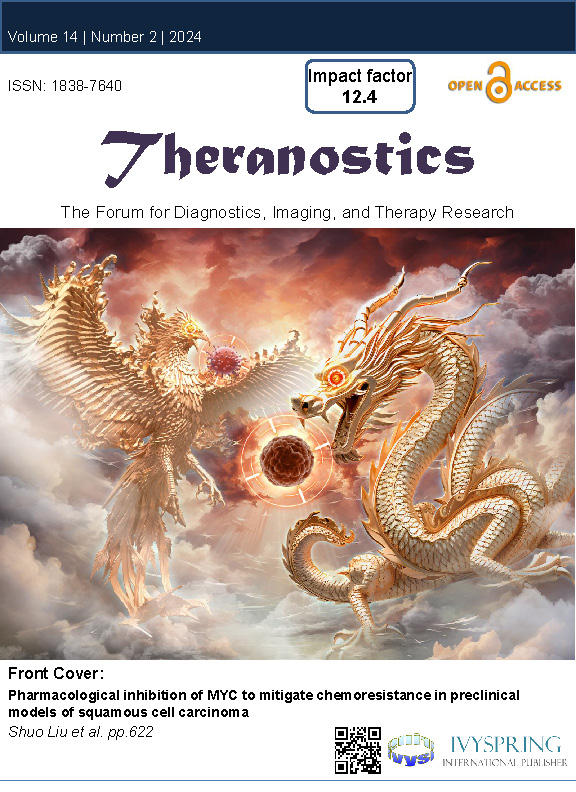Targeted degradation of VEGF with bispecific aptamer-based LYTACs ameliorates pathological retinal angiogenesis
IF 12.4
1区 医学
Q1 MEDICINE, RESEARCH & EXPERIMENTAL
引用次数: 0
Abstract
Rationale: Neovascular ocular diseases (NODs) represent the leading cause of visual impairment globally. Despite significant advances in anti-angiogenic therapies targeting vascular endothelial growth factor (VEGF), persistent challenges remain prevalent. As a proof-of-concept study, we herein demonstrate the effectiveness of targeted degradation of VEGF with bispecific aptamer-based lysosome-targeting chimeras (referred to as VED-LYTACs)./nMethods: VED-LYTACs were constructed with three distinct modules: a mannose-6-phosphate receptor (M6PR)-binding motif containing an M6PR aptamer, a VEGF-binding module with an aptamer targeting VEGF, and a linker essential for bridging and stabilizing the two-aptamer structure. The degradation efficiency of VED-LYTACs via the autophagy-lysosome system was examined using an enzyme-linked immunosorbent assay (ELISA) and immunofluorescence staining. Subsequently, the anti-angiogenic effects of VED-LYTACs were evaluated using in vitro wound healing assay, tube formation assay, three-dimensional sprouting assay, and ex vivo aortic ring sprouting assay. Finally, the potential therapeutic effects of VED-LYTACs on pathological retinal neovascularization and vascular leakage were tested by employing mouse models of NODs./nResults: The engineered VED-LYTACs promote the interaction between M6PR and VEGF, consequently facilitating the translocation and degradation of VEGF through the lysosome. Our data show that treatment with VED-LYTACs significantly suppresses VEGF-induced angiogenic activities both in vitro and ex vivo. In addition, intravitreal injection of VED-LYTACs remarkably ameliorates abnormal vascular proliferation and leakage in mouse models of NODs./nConclusion: Our findings present a novel strategy for targeting VEGF degradation with an aptamer-based LYTAC system, effectively ameliorating pathological retinal angiogenesis. These results suggest that VED-LYTACs have potential as therapeutic agents for managing NODs.用基于双特异性适配体的 LYTACs 靶向降解血管内皮生长因子,改善病理性视网膜血管生成
理由:新生血管性眼病(NOD)是全球视力损伤的主要原因。尽管以血管内皮生长因子(VEGF)为靶点的抗血管生成疗法取得了重大进展,但持续存在的挑战依然普遍存在。作为一项概念验证研究,我们在此证明了使用基于双特异性适配体的溶酶体靶向嵌合体(简称 VED-LYTACs)靶向降解血管内皮生长因子的有效性:VED-LYTACs由三个不同的模块构成:含有M6PR适配体的甘露糖-6-磷酸受体(M6PR)结合基团、含有靶向血管内皮生长因子的适配体的血管内皮生长因子结合模块以及桥接和稳定双适配体结构所必需的连接体。使用酶联免疫吸附试验(ELISA)和免疫荧光染色法检测了VED-LYTACs通过自噬-溶酶体系统的降解效率。随后,使用体外伤口愈合试验、管道形成试验、三维发芽试验和体外主动脉环发芽试验评估了 VED-LYTACs 的抗血管生成作用。最后,利用小鼠 NODs 模型测试了 VED-LYTAC 对病理性视网膜新生血管和血管渗漏的潜在治疗效果:工程化的 VED-LYTACs 可促进 M6PR 与血管内皮生长因子之间的相互作用,从而促进血管内皮生长因子通过溶酶体转运和降解。我们的数据显示,用 VED-LYTACs 治疗可显著抑制血管内皮生长因子诱导的体外和体内血管生成活性。此外,静脉注射 VED-LYTACs 还能明显改善 NODs 小鼠模型中血管的异常增殖和渗漏:我们的研究结果提出了一种利用基于适配体的 LYTAC 系统靶向降解血管内皮生长因子的新策略,可有效改善病理性视网膜血管生成。这些结果表明,VED-LYTAC 有可能成为治疗 NOD 的药物。
本文章由计算机程序翻译,如有差异,请以英文原文为准。
求助全文
约1分钟内获得全文
求助全文
来源期刊

Theranostics
MEDICINE, RESEARCH & EXPERIMENTAL-
CiteScore
25.40
自引率
1.60%
发文量
433
审稿时长
1 months
期刊介绍:
Theranostics serves as a pivotal platform for the exchange of clinical and scientific insights within the diagnostic and therapeutic molecular and nanomedicine community, along with allied professions engaged in integrating molecular imaging and therapy. As a multidisciplinary journal, Theranostics showcases innovative research articles spanning fields such as in vitro diagnostics and prognostics, in vivo molecular imaging, molecular therapeutics, image-guided therapy, biosensor technology, nanobiosensors, bioelectronics, system biology, translational medicine, point-of-care applications, and personalized medicine. Encouraging a broad spectrum of biomedical research with potential theranostic applications, the journal rigorously peer-reviews primary research, alongside publishing reviews, news, and commentary that aim to bridge the gap between the laboratory, clinic, and biotechnology industries.
 求助内容:
求助内容: 应助结果提醒方式:
应助结果提醒方式:


